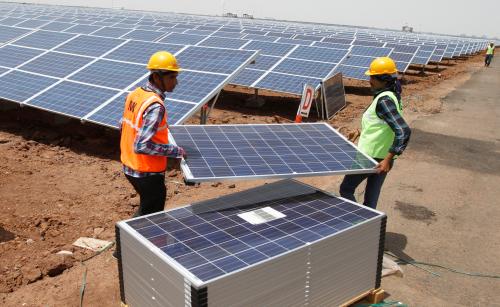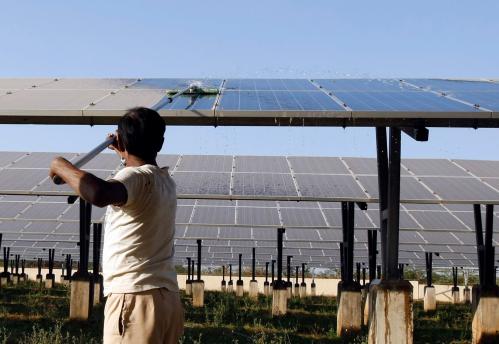Content from the Brookings Institution India Center is now archived. After seven years of an impactful partnership, as of September 11, 2020, Brookings India is now the Centre for Social and Economic Progress, an independent public policy institution based in India.
This article is a part of India 2024: Policy Priorities for the New Government, a compendium of policy briefs from scholars at Brookings India, which identifies & addresses some of the most pressing challenges that India is likely to face in the next five years.
How things change in five years. We have seen many positive steps, some with effort, some part of broader global trends. Nearly all homes in India today have an electricity connection, and the prices of solar power have crashed to a level where newspapers talk of “grid parity.” Carbon is a universal global concern, and India made a carbon reduction promise at the Paris Climate Summit that it is likely to keep.
Going forward, government policies must focus on all the three aspects of sustainability: economics, environment, and equity. Sustainability isn’t just about “being green” or an elite construct, even laypersons want improved energy access and affordability, and pollution impacts them the most.
While all countries grapple with sustainability, India is different given its starting point: a large base, growing demand, but still modest use of modern energy. Despite strides with schemes like Ujjwala, many rural homes still use biomass for cooking, and the per capita electricity consumption is still only a third the global average. While business as usual will keep improving, it will not be enough to meet the often conflicting goals of cheaper, faster, and better.
If years of under-supply and shortages of power are a thing of the past, then why are utilities not providing 24×7 power to all? Of course, the obvious challenges will need to be addressed, such as the reduction of distribution company (Discom) losses such as theft, and moving to better emissions standards for vehicles. But some challenges need a new direction and political will – we need to now focus not merely on yesterday’s problems but tomorrow’s.
Improve Electricity Supply
While no one is against the goal of 24×7 electricity supply how can it happen viably, and how can it be verified? Utilities and regulators must bite the bullet to buy sufficient power or those who are load shed more (the poor and rural users) end up worse off than urban dwellers, effectively a perverse reverse cross-subsidy. Furthermore, digitalisation of the infrastructure – starting with real-time feeder monitoring – is required to verify supply. This does not require smart meters per se, which are helpful but will take time. Through improved planning and building system resiliency, an immediate step would be to end scheduled load-shedding, a precursor to ending unscheduled load-shedding.
Part of the challenge is that this is not a generation problem anymore. Instead, what is required is to incentivise the right power generation at the right time at the right price. Not only is India relatively power surplus for now, the costs of renewable energy (RE) are quite low, especially compared to alternatives. However, RE, as used today is the low-hanging fruit of variable renewable energy (VRE), and at some point in a few years, we will need sufficient storage to handle so much RE. Most demand remains in the evening peak. Thus, time of day pricing is necessary to ensure not just that supply matches demand but that demand matches available supply. Time of day pricing should start with wholesale purchases before addressing concerns about retail supply, which will require massive metering upgrades. In the long run, a higher RE system needs operational flexibility, which means more market mechanisms, instead of today’s static if not rigid power purchase agreements.
Enhance Efficiency
Cheap supply, even if from RE, is not as useful as lower demand, which also saves on infrastructure requirements, which is why efficiency matters. While there are star ratings for appliances, buildings are an obvious laggard, and the gap is not just in norms but in enforcement. Part of this is a supply problem. Although LED bulbs have been widely adopted, many efficient appliances are only sold as luxury or elite products. Lack of competitive and affordable choices is also why there is little clamour for electric vehicles: it is not just lack of charging infrastructure. In fact, the first significant users of electric vehicles in India are likely to be fleets and public transport, who can fend for themselves, or small vehicles that can manage with regular household charging, especially overnight. But without effort, that could mean more coal.
Eliminate Distortions through Better Regulation
India must use the next few years to undertake structural change for superior regulation and stakeholder incentives. Traditional electricity was mostly regulated and costs-plus, with many distortions, including in fuel markets. It is now time to remove distortions and enable more market-oriented competition. The future will involve more digitally-enabled disruption from the edge: “Uberization” so to speak. Instead of fighting this, India should embrace more distributed generators and storage, and demand shifting by end-users and third parties. Many users do deserve support in the form of subsidies, but this should be applied judiciously only for lifeline usage, and technology can help enforce this. If support continues in the form of cheap prices, consumers have no incentive to save energy. Instead they can be given separate subsidies, perhaps through direct benefit transfers (DBT).
Sadly, we can’t innovate ourselves out of our problems — solar or smart meters can help but are not enough to address systems-level issues. With all the solar pumpsets being implemented to solve Discom woes, at what point would we run out of water before we run out of power?
Path Ahead
Operational improvements should be accompanied by amendments to the Electricity Act 2003. No-brainers include increasing the use of technology and ushering in new entrants. There is also an opportunity to fix or tweak issues that need more clarity or options, especially relating to markets, competition, and structural separation of wires and retail. Given the complexities and tradeoffs, the processes must draw in more stakeholders, especially states and cities, not to mention technology providers and consumers. We also need to embrace and take advantage of our heterogeneity – one size does not fit all. Forward-looking utilities should be supported for ambitious targets, and even taking greater risks.
When incrementalism isn’t enough, we have to consider a big bang. We need clear measurable goals that are achievable but with effort. If a utility is truly failing, it should face consequences, and there should be external oversight of many operations. After all, entire cities in the west go into receivership when they fail.
Energy transitions take time, even though governments like to think in terms of five years. India has to play the long game. The good news is India is likely to surprise critics by a faster thrust towards digitalisation, de-centralisation, and de-carbonising. Smart grids and consumer engagement in the West are often viewed with indifference if not suspicion. In India, few people take electricity for granted. Citizens are likely to embrace change if it makes their lives better. We just need policies that can foster and accelerate positive change.




Commentary
India 2024: A sustainable India
May 17, 2019